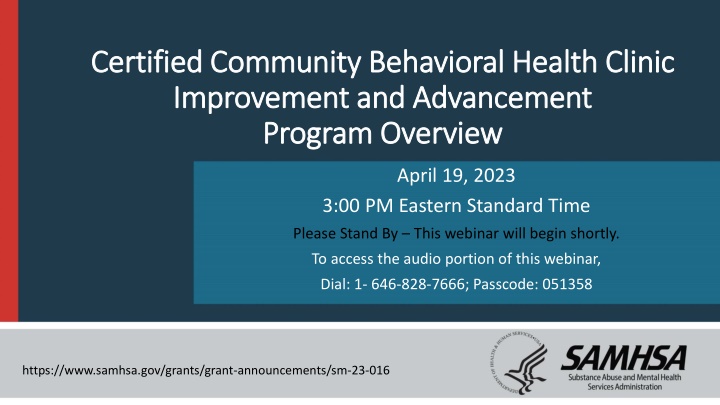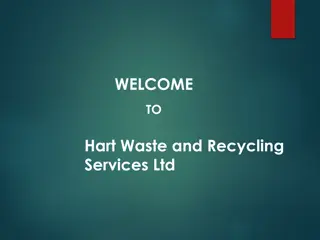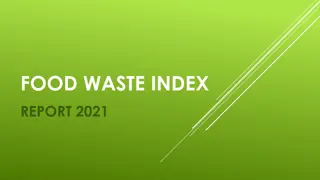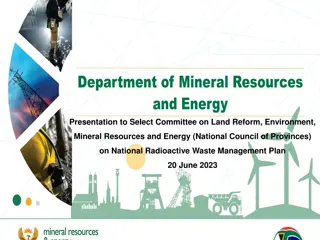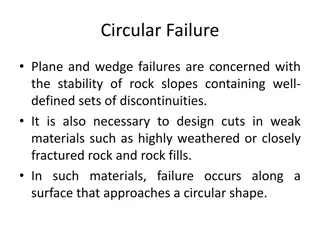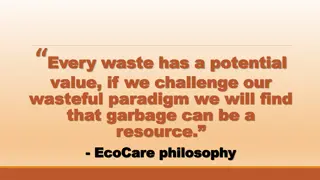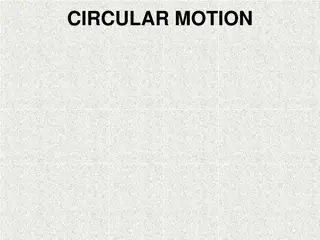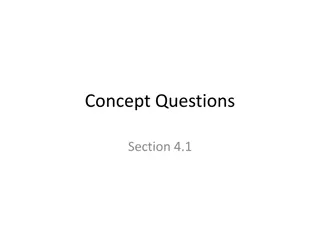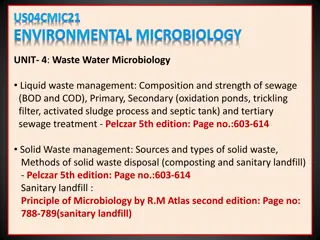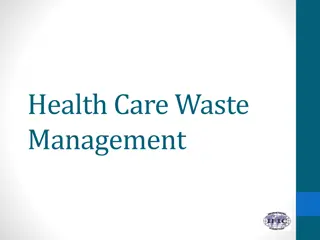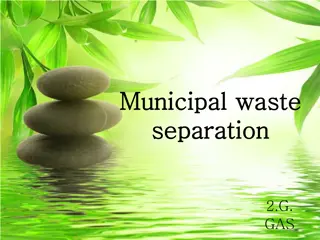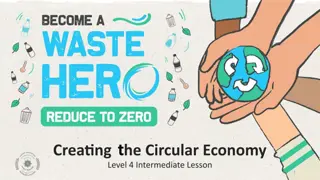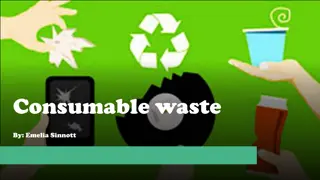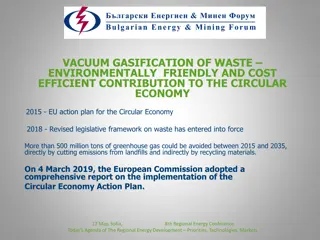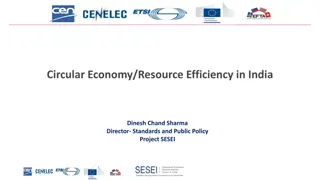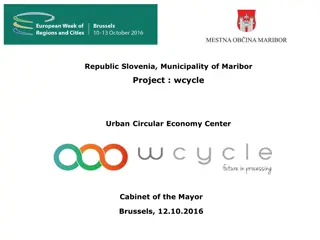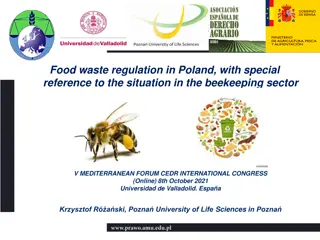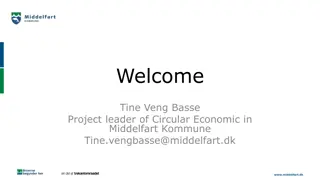Circular Economic Opportunities through University Food Waste Reduction
College students generate substantial edible food waste annually. Learn how Northern Michigan University is exploring ways to reduce food waste through a circular economic model. Discover the findings on students' favorite restaurants, perceptions of campus dining locations, and ongoing efforts for waste reduction.
Download Presentation

Please find below an Image/Link to download the presentation.
The content on the website is provided AS IS for your information and personal use only. It may not be sold, licensed, or shared on other websites without obtaining consent from the author.If you encounter any issues during the download, it is possible that the publisher has removed the file from their server.
You are allowed to download the files provided on this website for personal or commercial use, subject to the condition that they are used lawfully. All files are the property of their respective owners.
The content on the website is provided AS IS for your information and personal use only. It may not be sold, licensed, or shared on other websites without obtaining consent from the author.
E N D
Presentation Transcript
Certified Community Behavioral Health Clinic Certified Community Behavioral Health Clinic Improvement and Advancement Improvement and Advancement Program Overview Program Overview April 19, 2023 3:00 PM Eastern Standard Time Please Stand By This webinar will begin shortly. To access the audio portion of this webinar, Dial: 1- 646-828-7666; Passcode: 051358 https://www.samhsa.gov/grants/grant-announcements/sm-23-016
Basic Information Funding Opportunity Number: SM-23-016 Estimated Total Available Funding: $61,800,000 Estimated Number of Awards: Up to 62 Estimated Award Amount: $1,000,000 Cost Sharing/Match Required: No Length of Project Period: Up to 4 Years Application Due Date: Monday, May 22, 2023 Anticipated Project Start Date: September 30, 2023 2
Program Purpose and Intent (NOFO Section I.1 p. 7) Transform community behavioral health systems and provide comprehensive, coordinated behavioral health care by enhancing and improving CCBHCs that meet the CCBHC Certification Criteria CCBHCs provide a comprehensive range of outreach, screening, assessment, treatment, care coordination, and recovery supports based on a needs assessment with fidelity to the CCBHC Certification Criteria. The CCBHC-IA program: o Is designed to improve access to quality, integrated, and person-centered community-based mental health and substance use disorder treatment and support, including 24/7 crisis services, to anyone in their service area who needs it, regardless of their ability to pay or place of residence. o Supports existing CCBHCs to further expand or improve their CCBHC services. 3
Expectations (NOFO Section I.1 p. 8) SAMHSA expects that this program will improve behavioral health care for individuals across the lifespan by supporting providers to operate in accordance with the federal CCBHC criteria and: Support recovery from mental health and substance use disorder challenges via comprehensive community-based mental and substance use disorder treatment and supports; Increase access to and availability of high- quality services that are responsive to the needs of the community; Meaningfully involve consumers and family members in their own care and the broader governance of the CCBHC. Use evidence-based practices that address the needs of the individuals the CCBHC serves; Continually work to measure and improve the quality of services; and Note: SAMHSA has updated the CCBHC Certification Criteria and the revised Criteria are posted on SAMHSA s website. CCBHCs that receive awards are expected to comply with the updated criteria by July 1, 2024. 4
Population of Focus (NOFO Section I.1 p. 7-8) Individuals across the lifespan with or at risk for mental illness and/or substance use disorders, including: Individuals with Serious Mental Illness (SMI) Individuals with Substance Use Disorders (SUD) Children and adolescents with Serious Emotional Disturbance (SED) Individuals with co-occurring mental and substance use disorders (CoD) SAMHSA expects that applicants will include a focus on groups facing health disparities, as identified in the community needs assessment in the population of focus. 5
Eligibility (NOFO section III.3 p. 20-21) Eligible applicants are organizations operating existing state-certified CCBHCs or CCBHCs that have successfully met all certification criteria as part of a prior CCBHC award. For the purposes of this NOFO, a CCBHC is defined as a behavioral health provider clinic that is individually responsible for meeting the six CCBHC criteria requirements and all nine services in a manner that meets or exceeds the standards set in the CCBHC certification criteria. Eligible organizations may submit separate applications for more than one clinic (e.g., a state or provider organization applying on behalf of multiple clinics). CCBHC-IA awards shall only be awarded to existing clinics as described above in this section. Please see Section III.3 (Other Requirements) and Section V.3 (Review and Selection Process) for additional information on review and selection of applications based on previous funding and other factors. It is recommended that you review the information on eligibility in Appendix C of the NOFO. 6
Eligibility (NOFO section III.3 p. 20) Be a state-certified CCBHC Submit a copy of the application submitted to the state for certification Submit a copy of notice or approval from the state demonstrating state certification. OR Have successfully met all certification criteria under a prior SAMHSA CCBHC- Expansion grant award Submit a copy of communication from SAMHSA accepting an attestation under a previous CCBHC-E grant award Submit a copy of the Attestation demonstrating certification compliance that was accepted by SAMHSA. 7
Eligibility/Other Requirements, contd Community-based behavioral health non-profit organizations, OR Organizations that are either: a) part of a local government behavioral health authority*; or b) operated under the authority of the Indian Health Service, an Indian tribe, or tribal organization; or c) an Urban Indian Organization pursuant to a grant or contract with the Indian Health Service under Title V of the Indian Health Care Improvement Act (25 U.S.C. 1601 et seq.). All non-profit entities (having a 501(c)(3) status with the Internal Revenue Service (IRS), must submit documentation of their non-profit status in Attachment 8 of your application. Please note: For-profit organizations and foreign entities are not eligible to apply for SAMHSA awards. *As provided for in the CCBHC Certification Criteria, a CCBHC is considered part of a local government behavioral health authority when a locality, county, region, or state maintains authority to oversee behavioral health services at the local level and utilizes the clinic to provide those services. (See Certified Community Behavioral Health Clinic (CCBHC) Certification Criteria Updated March 2023 (samhsa.gov)) 8
Eligibility/Other Requirements, contd Applicants must submit a letter from the state or territory Mental Health Authority in Attachment 10 indicating approval of the applicant s proposal to improve and advance a clinic within the state/territory and whether the state will assume responsibility for CCBHC certification. This requirement is waived for Tribal applicants. If the applicant received funding in a FY 2022 CCBHC award under CCBHC-PDI (SM-22-002) and/or CCBHC-IA (SM- 22-012) NOFOs, the proposed project must be to advance or improve an independent clinic that serves a different service area. Applicants supporting an independent clinic serving a different service area from the funding they received in SM-22-002 and/or SM-22-012 must submit a letter as described in Appendix O of this NOFO with their application in Attachment 12 or the application will not be reviewed. If submitting applications for both CCBHC-PDI (SM-23-024) and CCBHC-IA (SM-23-016) NOFOs, the application for CCBHC-IA must improve or advance an existing, independent CCBHC that serves a different service area from the CCBHC being developed under the CCBHC-PDI application. Applicants submitting applications for both CCBHC-IA (SM-23-016) and CCBHC-PDI (SM-23-024) must submit a letter as described in Appendix P of this NOFO with their application under Attachment 13 or the application will not be reviewed. The Project Narrative must not exceed 10 pages. If the Project Narrative is over 10 pages, the application will not be considered for review. 9
Evidence of Experience and Credentials (NOFO section III.3 p. 22-23) Applicants must submit evidence in Attachment 1 of their application meeting three additional requirements related to the provision of services. Be licensed, certified, and/or approved by the state to provide mental health AND SUD services across the lifespan at the time of application and must comply with all applicable local (city, county) and state licensing, accreditation, and certification requirements, as of the due date of the application. If the applicant is proposing to have Designated Collaborating Organizations (DCOs), each DCO must be licensed, certified, and/or approved by the state to provide the relevant scope of services appropriate to the grant. Each mental health/SUD treatment provider organization (this includes the applicant organization performance sites and any DCOs participating in the grant) must have at least two years of experience (as of the due date of the application) providing relevant services (official documents must establish that the organization has provided relevant services for the last two years) to ensure that the organization has experience in providing relevant services. Each mental health/SUD treatment provider organization (this includes the applicant organization performance sites and any DCOs participating in the grant) must comply with all applicable local (city, county) and state licensing, accreditation, and certification requirements, as of the due date of the application.
Required Application Components (NOFO Section IV) Budget Information (NOFO, p. 24) SF-424A (p. 24) Budget Justification and Narrative Example See Appendix L (p. 81) Project Narrative (p. 25) Attachments 1 12 (pgs. 25 - 27) Attachment 1: Direct Service Provider Organizations (p. 25) Attachment 2: Data Collection Instruments/Interview Protocols (p. 25) Attachment 3: Sample Consent Forms (p. 26) Attachment 4: Project Timeline (p. 26) 11
Required Application Components, contd Attachment 5: Biographical Sketches and Position Description See Appendix G (p. 64) Attachment 6: Letter to Single State Agency (SSA) - See Appendix J (p. 72) Attachment 7: Confidentiality and Participant Protection/Human Subject Guidelines - See Appendix D (p. 54) Attachment 8: Documentation of Non-Profit Status (p. 26) Attachment 9: Form SMA 170 Assurance of Compliance with SAMHSA Charitable Choice Statutes and Regulations (p. 27) 12
Required Application Components, contd Attachment 10: Letter from the State/Territory Mental Health Authority (this requirement is waived for tribal applicants) (p. 27) Attachment 11: Documentation of Meeting CCBHC Certification Criteria Requirements(p. 27) Attachment 12: Letter for Recipients of FY2022 CCBHC PDI/IA Awards, if applicable - See Appendix O for Format (pgs. 27 & 108) Attachment 13: Letter for Organizations Submitting Multiple Applications Under CCBHC-PDI (SM-23-024) and CCBHC-IA (SM-23-016), if applicable- See Appendix P (pgs. 27 & 109) 13
Application Submission (NOFO Section IV.4) All applicants must register with NIH s eRA Commons in order to submit an application. This process takes up to six weeks. If you believe you are interested in applying for this opportunity, start the registration process immediately. Do not wait to start this process. SEE APPENDIX A FOR DETAILED INSTRUCTIONS 14
Application Submission You are required to complete three (3) registration processes: System for Award Management (SAM); Grants.gov; and eRA Commons. If you have already completed registrations for SAM, and Grants.gov, you need to ensure that your accounts are still active, and then register in eRA Commons. SEE APPENDIX A FOR DETAILED INSTRUCTIONS 15
Key Staff (NOFO, Section I.2) Key personnel are staff members who must be part of the project regardless of whether or not they receive a salary or compensation from the project. These staff members must make a substantial contribution to the execution of the project. The Key Personnel for this program: Project Director, minimum level of effort of 0.5 FTE Evaluator, minimum level of effort of 0.5 FTE These positions require prior approval by SAMHSA after a review of staff credentials and the job descriptions.
Required Activities (NOFO, Section I.3) Project implementation is expected to begin by the fourth month from the date funding is made available. You must use SAMHSA s services grant funds primarily to support direct services: Throughout the project period operate in compliance with the CCBHC Certification Criteria (https://www.samhsa.gov/sites/default/files/ccbhc- criteria-2023.pdf). Recipients will be expected to comply with the updated criteria by July 1, 2024. If operating under a state CCBHC certification program, collaborate with the state to maintain state CCBHC certification. 17
Required Activities, contd Provide all nine core CCBHC services, as described in the Certification Criteria, Program Area 4, Scope of Services: o Crisis mental health services, including 24-hour mobile crisis teams, emergency crisis intervention services, and crisis stabilization. o Screening, assessment, and diagnosis, including risk assessment. o Patient-centered treatment planning or similar processes, including risk assessment and crisis planning. o Outpatient mental health and substance use services. o Outpatient clinic primary care screening and monitoring of key health indicators and health risks (e.g., BMI, blood pressure, tobacco use, HIV/Viral Hepatitis). o Targeted case management. o Psychiatric rehabilitation services. o Peer support, counselor services, and family supports. o Intensive, community-based mental health for members of the armed forces and veterans. 18
Required Activities, contd Conduct at least one (1) and possibly two (2) community needs assessments over the life of the project as provided for below: o Within three years of the most recent CCBHC needs assessment (as specified in Certification Criteria 1.a.1. and every three years thereafter, conduct a needs assessment for the population(s) of focus, including: (1) the availability and accessibility of services; and (2) the cultural, linguistic, and treatment needs, including the needs of sub-populations (e.g., racial, ethnic, gender, sexual orientation) who experience disparities in access to and outcomes from behavioral health services. Input from consumers1 and family members shall be integrated into the assessment. Within six months of completing each needs assessment, submit to SAMHSA an attestation that you have met the CCBHC Certification Criteria and provide additional adjustments to the attestation, as necessary, to demonstrate compliance; OR if participating with the state to maintain CCBHC certification, submit to SAMHSA documentation demonstrating state certification compliance. As described in the CCBHC Certification Criteria, meaningfully involve consumers and family members in designing, providing, monitoring, evaluating program services and participating in or providing meaningful input to the CCBHC board (Certification Criteria 1.a, 1.c, 3.a, 4.j, 4.k, 5, and 6.b). 19
Required Activities, contd Implement infrastructure development activities needed to address operational and activities needed to continue meeting the certification criteria and improve the quality and effectiveness of CCBHC services. [NOTE: No more than 15 percent of the annual funding award may be used for infrastructure]. The infrastructure activities are the following: o Maintain Health Information Technology (HIT) systems to facilitate care coordination (Certification Criteria 3.b). o Supporting electronic health information exchange to improve care transition (Certification Criteria 3.b). o Updating and maintaining care coordination agreements with partners (Certification Criteria 3.c). o Supporting processes and procedures for collecting, reporting, and tracking encounter, outcome, and quality data (Certification Criteria 5.a). o Updating and implementing a CCBHC-wide data-driven continuous quality improvement (CQI) plan for clinical services and clinical management (Certification Criteria 5.b). Within one year of grant award, develop and implement a sustainability plan to support delivery of services once federal grant funding ends; and update the sustainability plan annually. 20
Allowable Activities (NOFO, Section I.4) Incorporate measurement-based care into program implementation. Measurement- based care (MBC) is an evidence-based strategy to improve service outcomes that involves the systematic administration of symptom rating scales and use of the results to drive clinical decision-making. Develop and implement tobacco cessation programs, activities, and/or strategies. Implement activities that address behavioral health disparities and the social determinants of health within the scope of services and activities described under the CCBHC Certification Criteria. Partnership development with other service providers and stakeholders. Development/revision of credentialing, licensure, or accreditation requirements. 21
Allowable Activities, contd Training/workforce development to help your staff or other providers in the community identify mental health or substance abuse issues or provide effective services consistent with the CCBHC model. Cultural competency and implicit bias reduction training to service providers to increase awareness and acknowledgment of differences in language, age, culture, socio-economic status, political and religious beliefs, sexual orientation and gender identity, and life experiences. Policy development to support needed service system improvements (e.g., rate-setting activities, establishment of standards of care, adherence to the Behavioral Health Guide for the National Standards for Culturally and Linguistically Appropriate Services (CLAS) in Health and Health Care). 22
Changes/Clarifications from the FY2022 CCBHC-IA NOFO Eligible organizations may submit separate applications for more than one clinic. o Each clinic must serve a different non-overlapping geographic catchment area. Each clinic may only receive one award from either this NOFO or the concurrent CCBHC-PDI NOFO No clinic may have two concurrent CCBHC expansion awards (from either IA or PDI competitions). Clinics that received an award under SM-22-002 (PDI) or SM-22-012 (IA) are not eligible to apply for this funding announcement. Each award may only support one clinic, not multiple clinics. Eligibility Added activity re start of implementation, service delivery and data collection. Added requirement to participate in SAMHSA-funded TTA Modified language related to cultural competency training and adherence to CLAS standards Removed Implementation Science Pilot Allowable Activity and replaced with more general activity to work with implementation-based science professionals/researchers to enhance implementation of the elements of the program. Required/ Allowable Activities 9
Changes/Clarifications from the FY2022 CCBHC-IA NOFO, contd Additional clarifications re expectations for Key Staff positions of Project Director and Evaluator Key Staff Applicant to provide letters for commitment from DCOs and other agencies with whom they have a MOA/MOU Attachment 1 Documentation of Meeting CCBHC Certification Criteria Requirements. Attach both of the following: o(a) a record of state certification OR communication from SAMHSA accepting an attestation as a part of a previous expansion award AND o b) any supporting documentation provided to the state or SAMHSA that demonstrated certification compliance. Attachment 11 NOTE: Applications that do not comply with this requirement will be screened out and will not be reviewed. 10
Changes/Clarifications from the FY2022 CCBHC-IA NOFO, contd Applicants supporting a new clinic who received funding from SM-22-002 or SM-22-012 must submit a letter as described in Appendix O of this NOFO or the application will not be reviewed. Attachment 12 Applicants submitting applications for both CCBHC-PDI (SM- 23-024) and CCBHC-IA (SM-23-016) must submit a letter as described in Appendix P of the NOFO or the application will not be reviewed. Attachment 13 25
Evidence-Based Practices (NOFO Section I.5) SAMHSA s services grants are intended to fund services or practices that have a demonstrated evidence base and that are appropriate for the population(s) of focus. While SAMHSA realizes that EBPs have not been developed for all populations and/or service settings, application reviewers will closely examine proposed interventions for evidence base and appropriateness for the population of focus. If an EBP(s) exists for the population(s) of focus and types of problems or disorders being addressed, the expectation is that EBP(s) will be utilized. If one does not exist, but there are evidence-informed and/or culturally promising practices that are appropriate or can be adapted, these interventions may be implemented in the delivery of services. In your Project Narrative, in response to Section C of Section V of this NOFO, you will need to: o identify the evidence-based practice(s) and/or interventions that are evidence-informed and/or culturally promising that are appropriate or can be adapted to meet the needs of your specific population(s) of focus. o discuss the population(s) for which the practice(s) has (have) been shown to be effective and document that it is (they are) appropriate for your population(s) of focus. o address how these interventions will improve outcomes and address how you will monitor and ensure fidelity of EBPs and other appropriate interventions. 26
Data Collection/Performance Measurement (NOFO Section I.6) Recipients are required to collect and report NOMS client level data in SPARS at baseline, six months post baseline, and discharge. The number of organizations collaborating/coordinating/ sharing resources with other organizations as a result of the grant. Collect and report quarterly Infrastructure, Prevention, and Promotion (IPP) data to include, but not limited to: The number of work group/advisory group/council members who are consumers/family members as a result of the grant. The number of people receiving evidence-based mental health-related services as a result of the grant. The number and percentage of individuals receiving mental health or related services after referral. SPARS access, guidance, and technical assistance on data collection and reporting will be provided upon award. 27
Data Collection and Performance Measurement, contd Quality Measures: Recipients are required to collect data on the clinic-level quality measures required under the CCBHC Certification Criteria and report on these data in the annual progress performance report each year. Collection of clinic-level measures data should begin in the first year. Guidance on collection and reporting of clinic-level quality measures will be provided following award. National Evaluation: Recipients are required to participate fully in all aspects of the evaluation. National evaluation activities can include but are not limited to: 1. identifying and providing access to existing data sources and data analysis results; 2. assisting with organizing evaluation team on-site visits; 3. participating in interviews or focus groups; 4. reviewing and providing input into and feedback on evaluation plans and reports; and 5. helping the evaluation team to arrange for any necessary direct data collection that the evaluation team will conduct. This may include collection of additional client-level data and participation of sub-recipients. Details on the evaluation, including type of evaluation and research questions, will be provided upon award. 28
SAMHSA Grants and Confidentiality and Participant Protection All SAMHSA grantees are required to have safeguards protecting individuals from potential risks associated with their participation in SAMHSA projects, even if those projects are not focused on research All organizations that apply for SAMHSA grants must address all seven components of confidentiality and participant protection to ensure there are safeguards for participants and staff If you are working with individuals, there are potential risks to both participants and staff. 29
7 Components of Participant Protection 1. Protect Clients and Staff from Potential Risks 2. Fair Selection of Participants 3. Absence of Coercion 4. Data Collection 5. Privacy and Confidentiality 6. Adequate Consent Procedures 7. Risk/Benefits Discussion 30
Common Mistakes Not submitting a response to the participant protection guidelines with your application Stating that participant protection is not applicable since you are not conducting research Stating there are no foreseeable physical, medical, psychological, social, and legal risks or potential adverse effects as a result of the project. If your project involves individuals, there will be some level of risk or potential adverse effects. Only addressing participant protection as it relates to evaluation of the project. Not addressing all of the bulleted items within each of the seven components 31
Funding Limitations/Restrictions According to NOFO, Section IV.5. Funding Limitations/Restrictions: No more than 15 percent of the total grant award for the budget period may be used for developing the infrastructure necessary for expansion of services. No more than 20 percent of the total grant award for the budget period may be used for data collection, performance measurement, and performance assessment, including incentives for participating in the required data collection follow-up. Grant funds may not be used to provide services for in-patient settings, residential/inpatient substance abuse treatment facilities, or jails and prisons with the exception of in-reach, treatment planning, and transitional service to facilitate seamless coordination with community-based mental health and SUD services. No more than $30,000 per year may be used for the purchase of prescribed or over-the-counter medications. See also, Appendix I Standard Funding Restrictions
Application Evaluation Criteria (See NOFO, Section V.1) The Project Narrative (Sections A-E) together may be no longer than 10 pages. Section A: Population of Focus/Statement of Need (10 points approximately 1 page) Section B: Proposed Implementation Approach (30 points approximately 6 pages not including Attachment 4-Project Timeline) Section C: Proposed Evidence-Based Service/Practice (15 points approximately 1 pages) Section D: Staff and Organizational Experience (25 points approximately 1 page) Section E: Data Collection and Performance Measurement (20 points approximately 1 page) 33
Section A: Population of Focus and Statement of Need 1. Identify and describe your population(s) of focus and the geographic catchment area where services will be delivered that align with the intended population of focus of this program. Include a description of specific population(s) (i.e., race, ethnicity, sex, sexual orientation, gender identity, age, socioeconomic status) for which the grant seeks to address behavioral health disparities and the disparities that the grant will impact. 2. Describe the extent of the problem in the catchment area, including service gaps, and document the extent of the need (i.e., current prevalence rates or incidence data) for the population(s) of focus identified in your response to A.1. Identify the source of the data, including how your most recent CCBHC needs assessment was used to identify these issues. 34
Section B: Proposed Implementation Approach 1. Describe the goals and measurable objectives (see Appendix E) of the proposed project and align them with the Statement of Need described in A.2. 2. Describe how you will implement all of the Required Activities and, if applicable, Allowable Activities in Section I, including: a. A description of the specific services you will be implementing or improving as a result the project. b. Plans to conduct additional needs assessments during the project period as described under the Required Activities section of this NOFO. c. Your plan to maintain adherence to the CCBHC Certification Criteria throughout the project period. [NOTE: Be sure to describe the specific area(s) of advancement/improvement for the CCBHC that will be the focus of the project]. 35
Section B: Proposed Implementation Approach, contd 3. In Attachment 4, provide a chart or graph depicting a realistic timeline for the entire four years of the project period showing dates, key activities, and responsible staff. These key activities must include the requirements outlined in Section I. NOTE: Be sure to show that the project can be implemented, and service delivery can begin as soon as possible and no later than four months after award. The timeline cannot be more than two pages and should be submitted in Attachment 4. The recommendation of pages for this section does not include the timeline. 36
Section C: Proposed Evidence-Based Service/Practice 1. Identify the Evidence-Based Practice(s) (EBPs), evidence-informed, and/or culturally promising practices that will be used. Discuss how each intervention chosen is appropriate for your population(s) of focus and the outcomes you want to achieve. Describe any modifications (e.g., cultural) that will be made to the EBP(s) and the reason the modifications are necessary. If you are not proposing any modifications, indicate so in your response. 2. Describe how you will monitor and ensure fidelity of EBPs, evidence- informed and/or promising practices that will be implemented. 37
Section D: Staff and Organizational Experience 1. Describe your organization s capacity to deliver CCBHC services including: a. Past CCBHC state certifications or CCBHC attestations to SAMHSA and the timeline of your past CCBHC certifications or attestations. b. Capacity to provide services to the population(s) of focus for this NOFO: mental health and substance use disorder services for children, youth, and families as well as adults. c. Capacity to provide treatment and recovery support for mental illness, including serious mental illness and serious emotional disturbances, substance use disorder, and co-occurring mental and substance use disorders. 38
Section D: Staff and Organizational Experience, contd 2. Identify other organization(s) that you will partner with in the proposed project. Describe their experience providing services to the population(s) of focus, and their specific roles and responsibilities for this project. Letters of Commitment from direct service provider organizations to include all DCOs and other entities that have established memorandums of agreement or understanding to support the proposed project must be included in Attachment 1 of your application. If you are not partnering with any DCOs indicate so in your response. 3. Provide a complete list of staff positions for the project, including the Key Personnel (Project Director and Evaluator) and other significant personnel. Describe the role of each, their level of effort, and qualifications, including their experience providing services to the population(s) of focus and familiarity with their culture(s) and language(s). 39
Section E: Data Collection and Performance Measurement 1. Provide specific information about how you will collect the required data for this program and how such data will be utilized to manage, monitor, and enhance the program (See Appendix F). Describe your quality improvement efforts and explain how you will use the data to address your identified behavioral health disparity(ies) and close the gap(s). 2. Provide specific information about how you will collect the required CCBHC quality measures and how quality measure data will be used to manage, monitor, and improve the program. 40
Frequently Asked Questions Q. We are an organization looking to establish a CCBHC for the first time, but we have all the certification criteria already in place. Is the CCBHC-IA opportunity appropriate for us? A. If your clinic is not yet certified as a CCBHC by your state and if you have not received SAMHSA acceptance of attestation of meeting the CCBHC Certification Criteria requirements, then you are NOT eligible to apply for this NOFO, but you may be eligible to apply for the CCBHC-PDI (SM-23-024) NOFO, as long as you meet all other eligibility requirements (See Section III. Eligibility Information of the NOFO, Subsection 3. Other Requirements). Q. We are a prior CCBHC grantee. Can our organization apply for CCBHC-IA for our existing CCBHC clinic but also apply for the CCBHC-PDI in order to expand at new location in a different catchment area? A. If you received a FY2022 CCBHC-PDI or CCBHC-IA grant award for your existing CCBHC clinic, you are not eligible to apply for the FY2023 CCBHC-IA Notice of Funding Opportunity SM-23-016. However, your organization may be eligible to apply for SM-23-024 if you are planning to develop a new CCBHC in a different non-overlapping geographic catchment area from the existing CCBHC, and if the new clinic that will deliver all 9 core services and comply with the CCBHC Certification Criteria requirements within a year of award. 41
Frequently Asked Questions Q. If we are certified by our state, are we eligible to apply for either of the NOFOs? A. You are eligible to apply for CCBHC-IA (SM-23-016), as long as you meet all other Eligibility Requirements under Section III. Eligibility Information. If your clinic is certified by the state, you are NOT eligible to apply for the CCBHC-PDI (SM-22- 002). Please see pg. 8 of the NOFO, which states, "The intent of this program is for new CCBHCs. For clinics that had been certified in their state, but are not any longer being certified by the state as a CCBHC at the time of application, they should apply for the CCBHC-PDI NOFO (SM-22-002) Q. Does applying for another SAMHSA grant impact out opportunity to apply for this grant? A. Applying for another grant should not impact your ability to apply for either of the CCBHC funding opportunities, as long as your organization (including the clinic you are proposing to advance and improve as a CCBHC) meets the NOFO requirements and has the capacity to meet all grant requirement and implement more than one award. Q.Regarding all individuals across the lifespan, can the requirement to serve children impacted by SED be fulfilled by a Designated Collaborating Organization? Or is the grantee expected to directly provide specific services to that population? A. The CCBHC is required to have the capacity to treat children diagnosed with SED directly, although they may also use a DCO for specialty services. The CCBHC model requires that the CCBHC directly serve individuals across the lifespan. The Definition of a CCBHC in the CCBHC Certification Criteria, Appendix A clarifies that CCBHC s must have the capacity to serve children directly. 42
Frequently Asked Questions Q.When the reference is made to 1 site, does that mean that the grant applies to only a single clinic? What about agencies that have multiple CCBHC clinic sites? A. Yes, per the NOFO, each application should support one CCBHC. The expectation is that the application should advance, improve or advance one CCBHC that already meets the certification criteria independently and serves a separate catchment area. (Please note that a CCBHC clinic may have several service locations within their catchment area; however, the NOFO is not intended to support multiple CCBHCs that each independently meet the certification criteria.) Eligible applicant organizations may submit more than one CCBHC-IA application as long as each application is to implement a separate, independent clinic that is in compliance with the CCBHC Certification Criteria and meets all other eligibility requirements. Q.We are a prior CCBHC-E grant who was not awarded in 2022. Our attestation was completed in 2020. Is the SAMHSA acceptance of CCBHC Certification Attestation of meeting the CCBHC Certification Criteria from date the attestation was accepted (in 2020), or the time it covered (until July 22)? That would either qualify us or not. The CCBHC-PDI NOFO states it is for clinics who do not currently meet the criteria. Since we are a current CCBHC under a non-certified State (we currently are meeting the criteria), and if SAMHSA says it is based on the actual date of attestation, then technically we wouldn t qualify for either A. Given that you have had an attestation accepted in your prior grant award, you would be eligible to apply. However, you would likely need to complete a community needs assessment and submit a new attestation after award given the requirement of the NOFO to complete a community needs assessment and updated attestation every three years. 43
Thank you Contact Information Program Related Questions Budget/Fiscal Questions Review Process and Application Status Mary Blake Office of Financial Resources, Division of Grants Management Substance Abuse and Mental Health Services Administration FOACMHS@samhsa.hhs.gov Emily Chan Center for Mental Health Services Substance Abuse and Mental Health Services Administration ccbhc@samhsa.hhs.gov Office of Financial Resources, Division of Grant Review Substance Abuse and Mental Health Services Administration Emily.Chan@samhsa.hhs.gov
